- Nakshatra
-
Nakshatras Ashvinī Bharanī Kṛttikā Rohinī Mrigashīra Ārdrā Punarvasu Pushya Āshleshā Maghā Pūrva Phalgunī Uttara Phalgunī Hasta Chitrā Svātī Vishākhā Anurādhā Jyeshtha Mūla Pūrva Ashādhā Uttara Ashādhā Shravana Dhanistha Shatabhisha Pūrva Bhādrapadā Uttara Bhādrapadā Revatī Nakshatra (Devanagari: नक्षत्र nákṣatra) is the term for lunar mansion in Hindu astrology. A nakshatra is one of 27 (sometimes also 28) sectors along the ecliptic. Their names are related to the most prominent asterisms in the respective sectors.
The starting point for the nakshatras is the point on the ecliptic directly opposite to the star Spica called Chitrā in Sanskrit (other slightly different definitions exist). It is called Meshādi or the "start of Aries".[citation needed] The ecliptic is divided into each of the nakshatras eastwards starting from this point. The number of nakshatras reflects the number of days in a sidereal month (modern value: 27.32 days), that the width of a nakshatra is traversed by the moon in about one day. Each nakshatra is further subdivided into quarters (or padas) These play a role in popular Hindu astrology, where each pada is associated with a syllable, conventionally chosen as the first syllable of the given name of a child born when the moon was in the corresponding pada.
The nakshatras of traditional Hindu astronomy are based on a list of 28 asterisms found in the Atharvaveda (AVŚ 19.7) and also in the Shatapatha Brahmana.[citation needed] The first astronomical text that lists them is the Vedanga Jyotisha.
In classical Hindu mythology (Mahabharata, Harivamsa), the creation of the nakshatras is attributed to Daksha. They are personified as daughters of the deity and as mythological wives of Chandra, the moon god, or alternatively the daughters of Kashyapa, the brother of Daksha.[1]
Each of the nakshatras is governed as 'lord' by one of the nine graha in the following sequence: Ketu (South Lunar Node), Shukra (Venus), Ravi or Surya (Sun), Chandra (Moon), Mangala (Mars), Rahu (North Lunar Node), Guru or Brihaspati (Jupiter), Shani (Saturn) and Budha (Mercury). This cycle repeats itself three times to cover all 27 nakshatras. The lord of each nakshatra determines the planetary period known as the dasha, which is considered of major importance in forecasting the life path of the individual in Hindu astrology.
In Vedic Sanskrit, the term nákṣatra may refer to any heavenly body, or to "the stars" collectively. The classical sense of "lunar mansion" is first found in the Atharvaveda, and becomes the primary meaning of the term in Classical Sanskrit.
Contents
Nakshatras in the Atharvaveda
In the Atharvaveda (Shaunakiya recension, hymn 19.7) a list of 28 stars or asterisms is given, many of them corresponding to the later nakshatras:
(1) Kṛttikā (the Pleiads), (2) Rohinī, (3) Mrigashīrsha, (4) Ārdrā, (5) Punarvasu, (6) Sūnritā, (7) Pushya, (8) Bhanu (the Sun), (9) Asleshā, (10) Maghā, (11) Svāti (Arcturus), (12) Chitrā (Spica), (13) Phalgunis, (14) Hasta, (15) Rādhas, (16) Vishākhā, (17) Anurādhā, (18) Jyeshthā, (19) Mūla, (20) Ashādhas, (21) Abhijit, (22) Sravana, (23) Sravishthās, (24) Satabhishak, (25) Proshtha-padas, (26) Revati, (27) Asvayujas, (28) Bharani. [2]
List of Nakshatras
The classical list of 27 nakshatras is first found in the Vedanga Jyotisha, a text dated to the final centuries BCE.[citation needed].
In Hindu astrology, there are various systems of enumerating 27 or 28 nakshatras[3]. The following list of nakshatras gives the corresponding regions of sky, following Basham.[4]
No. Name Associated stars Description Image 1 Ashvini
"wife of the Ashvins"β and γ Arietis - Lord: Ketu (South lunar node)
- Symbol : Horse's head
- Deity : Ashvins, the horse-headed twins who are physicians to the gods
- Indian zodiac: 0° - 13°20' Mesha
- Western zodiac 26° Aries - 9°20' Taurus

2; 7 Bharani
"the bearer"35, 39, and 41 Arietis 
3 Krittika
an old name of the Pleiades; personified as the nurses of Kārttikeya, a son of Shiva.Pleiades 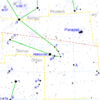
4; 9 Rohini
"the red one", a name of Aldebaran. Also known as brāhmīAldebaran 
5; 3 Mrigashīrsha
"the deer's head". Also known as āgrahāyaṇīλ, φ Orionis 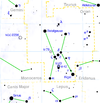
6; 4 Ardra
"the moist one"Betelgeuse - Lord: Rahu (North lunar node)
- Symbol: Teardrop, diamond, a human head
- Deity : Rudra, the storm god
- Indian zodiac: 6° 40' - 20° Mithuna
- Western zodiac: 2° 40' - 16° Cancer

7; 5 Punarvasu (dual)
"the two restorers of goods", also known as yamakau "the two chariots"Castor and Pollux - Lord: Guru (Jupiter)
- Symbol : Bow and quiver
- Deity : Aditi, mother of the gods
- Indian zodiac: 20° Mithuna - 3°20' Karka
- Western zodiac 16° - 29°20' Cancer

8; 6 Pushya
"the nourisher", also known as sidhya or tiṣyaγ, δ and θ Cancri 
9; 7 Āshleshā
"the embrace"δ, ε, η, ρ, and σ Hydrae - Lord: Budh (Mercury)
- Symbol: Serpent
- Deity : Sarpas or Nagas, deified snakes
- Indian zodiac: 16°40' - 30° Karka
- Western zodiac 12°40' - 26° Leo

10; 15 Maghā
"the bountiful"Regulus - Lord: Ketu (south lunar node)
- Symbol : Royal Throne
- Deity : Pitrs, 'The Fathers', family ancestors
- Indian zodiac: 0° - 13°20' Simha
- Western zodiac 26° Leo - 9°20' Virgo

11 Pūrva Phalgunī
"first reddish one"δ and θ Leonis - Lord: Shukra (Venus)
- Symbol : Front legs of bed, hammock, fig tree
- Deity : Bhaga, god of marital bliss and prosperity
- Indian zodiac: 13°20' - 26°40' Simha
- Western zodiac 9°20' - 22°40' Virgo

12 Uttara Phalgunī
"second reddish one"Denebola - Lord: Surya (Sun)
- Symbol: Four legs of bed, hammock
- Deity : Aryaman, god of patronage and favours
- Indian zodiac: 26°40' Simha- 10° Kanya
- Western zodiac 22°40' Virgo - 6° Libra

13 Hasta
"the hand"α, β, γ, δ and ε Corvi 
14 Chitra
"the bright one", a name of SpicaSpica - Lord: Mangala (Mars)
- Symbol: Bright jewel or pearl
- Deity : Tvastar or Vishvakarman, the celestial architect
- Indian zodiac: 23°20' Kanya - 6°40' Tula
- Western zodiac: 19°20' Libra - 2°40' Scorpio

15 Svāti
name of Arcturus (of unknown derivation)Arcturus - Lord: Rahu (north lunar node)
- Symbol: Shoot of plant, coral
- Deity : Vayu, the Wind god
- Indian zodiac: 6°40' - 20° Tula
- Western zodiac 2°40' - 16° Scorpio
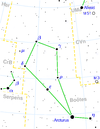
16; 14 Viśākhā
"forked, having branches"; also known as rādhā "the gift"α, β, γ and ι Librae 
17 Anuradha
"following rādhā"β, δ and π Scorpionis - Lord: Shani (Saturn)
- Symbol : Triumphal archway, lotus
- Deity : Mitra, one of Adityas of friendship and partnership
- Indian zodiac: 3°20' - 16°40' Vrishchika
- Western zodiac 29°20' Scorpio - 12°40' Sagittarius

18; 16 Jyeshtha
"the eldest, most excellent"α, σ, and τ Scorpionis - Lord: Budh (Mercury)
- Symbol : circular amulet, umbrella, earring
- Deity : Indra, chief of the gods
- Indian zodiac: 16°40' - 30° Vrishchika
- Western zodiac 12°40' - 26° Sagittarius
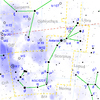
19; 17 Mula
"the root"ε, ζ, η, θ, ι, κ, λ, μ and ν Scorpionis - Lord: Ketu (south lunar node)
- Symbol : Bunch of roots tied together, elephant goad
- Deity : Nirrti, goddess of dissolution and destruction
- Indian zodiac: 0° - 13°20' Dhanus
- Western zodiac 26° Sagittarius - 9°20' Capricorn

20; 18 Purva Ashadha
"first of the aṣāḍhā", aṣāḍhā "the invincible one" being the name of a constellationδ and ε Sagittarii - Lord: Shukra (Venus)
- Symbol: Elephant tusk, fan, winnowing basket
- Deity : Apah, god of Water
- Indian zodiac: 13°20' - 26°40' Dhanus
- Western zodiac 9°20' - 22°40' Capricorn

21 Uttara Ashadha
"second of the aṣāḍhā"ζ and σ Sagittarii - Lord: Surya (Sun)
- Symbol : Elephant tusk, small bed
- Deity : Visvedevas, universal gods
- Indian zodiac: 26°40' Dhanus - 10° Makara
- Western zodiac 22°40' Capricorn - 6° Aquarius

22; 20 Abhijit
"victorious"[5]α, ε and ζ Lyrae - Vega Lord: Brahma 23; 20 Shravana α, β and γ Aquilae - Lord: Chandra (Moon)
- Symbol : Ear or Three Footprints
- Deity : Vishnu, preserver of universe
- Indian zodiac: 10° - 23°20' Makara
- Western zodiac 6° - 19°20' Aquarius

24; 21; 23 Shravishthā
"most famous", also Dhanishta "swiftest"α to δ Delphini - Lord: Mangala (Mars)
- Symbol : Drum or flute
- Deity : Eight vasus, deities of earthly abundance
- Indian zodiac: 23°20' Makara - 6°40' Kumbha
- Western zodiac 19°20' Aquarius - 2°40' Pisces

25; 22 Shatabhishaj
"requiring a hundred physicians"γ Aquarii - Lord: Rahu (north lunar node)
- Symbol : Empty circle, 1,000 flowers or stars
- Deity : Varuna, god of cosmic waters, sky and earth
- Indian zodiac: 6°40' - 20° Kumbha ; Western zodiac 2°40' - 16° Pisces

26; 3 Purva Bhadrapada
"the first of the blessed feet"α and β Pegasi - Lord: Guru (Jupiter)
- Symbol : Swords or two front legs of funeral cot, man with two faces
- Deity : Ajikapada, an ancient fire dragon
- Indian zodiac: 20° Kumbha - 3°20' Meena ; Western zodiac 16° - 29°20' Pisces

27; 4 Uttara Bhādrapadā
"the second of the blessed feet"γ Pegasi and α Andromedae - Lord: Shani (Saturn)
- Symbol : Twins, back legs of funeral cot, snake in the water
- Deity : Ahir Budhyana, serpent or dragon of the deep
- Indian zodiac: 3°20' - 16°40' Meena ; Western zodiac 29°20' Pisces - 12°40' Aries

28; 5 Revati
"prosperous"ζ Piscium - Lord: Budh (Mercury)
- Symbol : Fish or a pair of fish, drum
- Deity : Pushan, nourisher, the protective deity
- Indian zodiac: 16°40' - 30° Meena
- Western zodiac 12°40' - 26° Aries
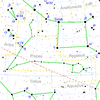
Padas (quarters)
The 27 Nakshatras cover 13°20’ of the ecliptic each. Each Nakshatra is also divided into quarters or padas of 3°20’, and the below table lists the appropriate starting sound to name the child. The 27 nakshatras, each with 4 padas, give 108, which is the number of beads in a japa mala, indicating all the elements (ansh) of Vishnu:
# Name Pada 1 Pada 2 Pada 3 Pada 4 1 Aśvini (अश्विनि)) चु Chu चे Che चो Cho ला La 2 Bharaṇī (भरणी) ली Li लू Lu ले Le पो Lo 3 Kṛttikā (कृत्तिका) अ A ई I उ U ए E 4 Rohini(रोहिणी) ओ O वा Va/Ba वी Vi/Bi वु Vu/Bu 5 Mṛgaśīrsha (म्रृगशीर्षा) वे Ve/Be वो Vo/Bo का Ka की Ke 6 Ārdrā (आर्द्रा) कु Ku घ Gha ङ Ng/Na छ Chha 7 Punarvasu (पुनर्वसु) के Ke को Ko हा Ha ही Hi 8 Puṣya (पुष्य) हु Hu हे He हो Ho ड Da 9 Āshleṣā (आश्लेषा) डी Di डू Du डे De डो Do 10 Maghā (मघा) मा Ma मी Mi मू Mu मे Me 11 Pūrva or Pūrva Phalgunī (पूर्व फाल्गुनी) नो Mo टा Ta टी Ti टू Tu 12 Uttara or Uttara Phalgunī (उत्तर फाल्गुनी) टे Te टो To पा Pa पी Pi 13 Hasta (हस्त) पू Pu ष Sha ण Na ठ Tha 14 Citrā (चित्रा) पे Pe पो Po रा Ra री Ri 15 Svātī (स्वाति) रू Ru रे Re रो Ro ता Ta 16 Viśākhā (विशाखा) ती Ti तू Tu ते Te तो To 17 Anurādhā (अनुराधा) ना Na नी Ni नू Nu ने Ne 18 Jyeṣṭha (ज्येष्ठा) नो No या Ya यी Yi यू Yu 19 Mūla (मूल) ये Ye यो Yo भा Bha भी Bhi 20 Pūrva Ashādhā (पूर्वाषाढ़ा) भू Bhu धा Dha फा Bha/Pha ढा Dha 21 Uttara Aṣāḍhā (उत्तराषाढ़ा) भे Bhe भो Bho जा Ja जी Ji 22 Śrāvaṇa (श्रावण) खी Ju/Khi खू Je/Khu खे Jo/Khe खो Gha/Kho 23 Śrāviṣṭha (श्रविष्ठा) or Dhaniṣṭha गा Ga गी Gi गु Gu गे Ge 24 Śatabhiṣā (शतभिषा)or Śatataraka गो Go सा Sa सी Si सू Su 25 Pūrva Bhādrapadā (पूर्वभाद्रपदा) से Se सो So दा Da दी Di 26 Uttara Bhādrapadā (उत्तरभाद्रपदा) दू Du थ Tha झ Jha ञ Da/Tra 27 Revatī (nakṣatra) (रेवती) दे De दो Do च Cha ची Chi Use in astrology
Hindu given names
Hindu astrologers (see Jyotisha) teach that when a child is born, they should be given an auspicious first name which will correspond to the child's Nakshatra. The technique for deducing the name is to see which nakshatra the moon is in at the moment of birth; this gives four possible sounds. A refinement is to pick one sound out of that four that relates to the Pada or division of the Nakshatra. Each Nakshatra has four Padas and four sounds and each Pada is of equal width. The Moon remains in each Nakshatra for approximately one day.
A further refinement or opportunity is to instead use the Nakshatra that the ascendent resides in at birth. The same broad choice of sounds and Padas apply, but now the sounds change roughly every 15 minutes. The ascendent passes through all 27 Nakshatras every 24 hours, being in each one for 53 and a third minutes of time, and is in a Pada for 13 and a third minutes of time. By using the ascendent's nakshatra, instead of the moon's nakshatra leads more to comfort of the Self, rather than comfort of the mother. This second approach is only really applicable if intuitively the moon approach does not feel right.
Electional astrology
Constellations are grouped on the basis of their nature, type of their face, degree of their beneficence, their quarters in different signs, with reference to the constellation occupied by the Sun, with reference to the birth constellation (Janma Nakshatra), their caste, etc. The current constellation occupied by the Moon, and its nature forms the fundamental of Vedic system of electional astrology (Muhurta). Some of the activities and works which are associated with the Nakshatras are given below based on their fundamental nature:
- Fixed (Dhruva, Sthira) constellations:
Rohini, Uttara Bhādrapadā, Uttra Phalguni, and Uttara Ashada
Fixed and permanent nature, house, village, temple, entering in new hose-city-temple, religious works, rites for getting peace, propitiation of portents, Vinayaka Shanti, coronation, sowing of seeds, planting of small garden, starting of vocal music, friendship, sexual works, making & wearing of ornaments & clothes may be auspiciously begun / effectively performed. Works allocated to delicate & friendly (Mridu) asterisms may also be performed.
- Movable (Chala , Chara) constellations:
Punarvasu, Swaati, Sharavana, Shatabhishā & Shravishthā
Related to motion & movement, riding on a vehicle or elephant, opening of shop, walking first time, walking in garden, sex, making jewellery, learning of a trait. Things performed in Small (Laghu) constellation are also effectively performed in the Movable constellations.
- Cruel (Ugra, Karur) constellations:
Magha, Bharani, Purva Phalguni, Purva Shadha, & Purva Bhadra.
Ambush, burning, poisoning (self & others), making & using weapons especially related to fire, cheating / deception / wickedness / craftiness, cutting & destroying, controlling of animals, beating & punishing of enemy. Works allocated to Sharp / Horrible (Darun) asterisms are also successfully done in these asterisms.
- Mixed (Mishra & Sadharan) constellations
Vishakha & Krittika.
Fire works, burning of sacred fire (Agnihotra), using poison, fearsome works, arresting, adulteration (mixing), donation of ox to get one’s desires fulfilled (Vrashotsarga). Works prescribed under cruel (Ugra, Karur) constellations may also be performed. As per N.S. works of Sweet / delicate & friendly (Mridu & Maitri) constellations can also be included.
- Small (Laghu & Kshipra) constellations
Hasta, Abhijit, Pushya, and Ashvini.
Selling, medical knowledge, using & handling of medicines, literature-music-art, the 64 Kala Shilpa (various arts, sculpture etc.) jewellery making & wearing, sexual intercourse. And the works prescribed for Movable (Char) constellations. Though Abhijit is included in Small group of asterisms, but is rarely referred in the Muhurt prescriptions.
- Sweet/Delicate & Friendly (Mridu & Maitri) constellations
Mrigashīrsha, Chitra, Anuradha and Revati.
Starting & learning singing of songs, clothes & jewellery making & wearing, Manglik works, matter related to friends, female company, enjoyments, sexual passions.
- Sharp & Horrible (Teekshan & Darun) constellations:
Jyeshta, Ardra, Ashlesha, and Mula
Charm or spell causing disease or death, hypnotism, sorcery; ghost, ambush, horror, murder, capture, matters related to secrecy, backbiting, starting of quarrel, separation, matters related to friendship & breaking thereof, training & tying of animals, pleasure works, playing games, getting made & wearing of new dress & ornaments, starting & learning singing of songs, entering into village / city, peaceful & developmental works.
See also
- Atmakaraka
- Navagraha
- Panchangam
- Gandanta
- Chinese constellation
- Twenty-eight mansions
References
- ^ Mythology of the Hindus, by Charles Coleman p.131
- ^ trans. Ralph T.H. Griffith, Hymns of the Atharva Veda, 1895[]. Original text via GRETIL from Gli inni dell’ Atharvaveda (Saunaka), trasliterazione a cura di Chatia Orlandi, Pisa 1991, collated with the ed. R. Roth and W.D. Whitney: Atharva Veda Sanhita, Berlin 1856.
- citrā́ṇi sākáṃ diví rocanā́ni sarīsr̥pā́ṇi bhúvane javā́ni | turmíśaṃ sumatím ichámāno áhāni gīrbhíḥ saparyāmi nā́kam
- suhávam agne kŕ̥ttikā róhiṇī cā́stu bhadráṃ mr̥gáśiraḥ śám ārdrā́ | púnarvasū sūnŕ̥tā cā́ru púṣyo bhānúr āśleṣā́ áyanaṃ maghā́ me
- púṇyaṃ pū́rvā phálgunyau cā́tra hástaś citrā́ śivā́ svātí sukhó me astu | rā́dhe viśā́khe suhávānurādhā́ jyéṣṭhā sunákṣatram áriṣṭa mū́lam
- ánnaṃ pū́rvā rāsatāṃ me aṣādhā́ ū́rjaṃ devy úttarā ā́ vahantu | abhijín me rāsatāṃ púṇyam evá śrávaṇaḥ śráviṣṭhāḥ kurvatāṃ supuṣṭím
- ā́ me mahác chatábhiṣag várīya ā́ me dvayā́ próṣṭhapadā suśárma | ā́ revátī cāśvayújau bhágaṃ ma ā́ me rayíṃ bháraṇya ā́ vahantu
- ^ А. И. Володарский (1975). "Астрономия в Древней Индии" (in Russian). Историко-астрономические исследования (Москва: Наука) 12: 237-238. http://books.google.com/books?id=NpS4AAAAIAAJ.
- ^ Arthur Llewellyn Basham, Indian Astronomy[year needed] Appendix: Astronomy.[page needed]
- ^ Its longitude starts from 06° 40' to 10° 53' 40 in sidereal Capricorn i.e. from the last quarter of Uttra Ashadha to first 1/15 th part of Shravana.[citation needed] Its span is 4° 13' 40.[citation needed] The span of 27 mean daily lunar motions totals 355.76167 degrees, and together these total 359.98945 degrees. Considered an "intercalary" lunar mansion.[citation needed]
Categories:- Hindu astrology
- Hindu astronomy
- Constellations
- Nakshatra
- Technical factors of astrology
- Sanskrit words and phrases
Wikimedia Foundation. 2010.
